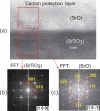Structural properties of ultrathin SrO film deposited on SrTiO3
- PMID: 31191758
- PMCID: PMC6542177
- DOI: 10.1080/14686996.2019.1599693
Structural properties of ultrathin SrO film deposited on SrTiO3
Abstract
The role of epitaxial strain and chemical termination in selected interfaces of perovskite oxide heterostructures is under intensive investigation because of emerging novel electronic properties. SrTiO (STO) is one of the most used substrates for these compounds, and along its direction allows for two nonpolar chemical terminations: TiO2 and SrO. In this paper, we investigate the surface morphology and crystal structure of SrO epitaxial ultrathin films: from 1 to about 25 layers grown onto TiO -terminated STO substrates. X-ray diffraction and transmission electron microscopy analysis reveal that SrO grows along its direction with a 4% out-of-plane elongation. This large strain may underlay the mechanism of the formation of self-organized pattern of stripes that we observed in the initial growth. We found that the distance between the TiO plane and the first deposited SrO layer is nm, a value which is about 40% bigger than in the STO bulk. We demonstrate that a single SrO-deposited layer has a different morphology compared to an ideal atomically flat chemical termination.
Keywords: 10 Engineering and Structural materials; 101 Self-assembly / Self-organized materials; 202 Dielectrics / Piezoelectrics / Insulators; 212 Surface and interfaces; 306 Thin film / Coatings; Pulsed laser deposition; epitaxial film; perovskite; surface termination; ultrathin film.
Figures








Similar articles
-
Controllable growth of ultrathin BiFeO3 from finger-like nanostripes to atomically flat films.Nanotechnology. 2016 Sep 2;27(35):355604. doi: 10.1088/0957-4484/27/35/355604. Epub 2016 Jul 25. Nanotechnology. 2016. PMID: 27454488
-
Optical properties of epitaxial BiFeO3 thin film grown on SrRuO3-buffered SrTiO3 substrate.Nanoscale Res Lett. 2014 Apr 23;9(1):188. doi: 10.1186/1556-276X-9-188. eCollection 2014. Nanoscale Res Lett. 2014. PMID: 24791162 Free PMC article.
-
Control of Epitaxial BaFe2As2 Atomic Configurations with Substrate Surface Terminations.Nano Lett. 2018 Oct 10;18(10):6347-6352. doi: 10.1021/acs.nanolett.8b02704. Epub 2018 Sep 11. Nano Lett. 2018. PMID: 30149722
-
Strain and orientation engineering in ABO3perovskite oxide thin films.J Phys Condens Matter. 2022 Feb 8;34(15). doi: 10.1088/1361-648X/ac4c61. J Phys Condens Matter. 2022. PMID: 35042194 Review.
-
Structure, Morphology and Reducibility of Epitaxial Cerium Oxide Ultrathin Films and Nanostructures.Materials (Basel). 2015 Aug 31;8(9):5818-5833. doi: 10.3390/ma8095278. Materials (Basel). 2015. PMID: 28793536 Free PMC article. Review.
Cited by
-
Surface Decorations on Mixed Ionic and Electronic Conductors: Effects on Surface Potential, Defects, and the Oxygen Exchange Kinetics.ACS Appl Mater Interfaces. 2023 Jun 7;15(22):26787-26798. doi: 10.1021/acsami.3c03952. Epub 2023 May 22. ACS Appl Mater Interfaces. 2023. PMID: 37212575 Free PMC article.
-
Oxidic 2D Materials.Materials (Basel). 2021 Sep 10;14(18):5213. doi: 10.3390/ma14185213. Materials (Basel). 2021. PMID: 34576436 Free PMC article. Review.
References
-
- Rondinelli JM, May SJ, Freeland JW.. Control of octahedral connectivity in perovskite oxide heterostructures: an emerging route to multifunctional materials discovery. MRS Bull. 2012;37(3):261–270.
-
- Ohtomo A, Hwang HY. A high-mobility electron gas at the LaAlO3/SrTiO3 heterointerface. Nature. 2004;427:423. - PubMed
-
- Koida T, Lippmaa M, Fukumura T, et al. Effect of a-site cation ordering on the magnetoelectric properties in [(LaMnO3)m/(SrMnO3)m]m artificial superlattices. Phys Rev B. 2002;66:144418.
-
- Nanda BRK, Satpathy S. Polar catastrophe, electron leakage, and magnetic ordering at the LaMnO3/SrMnO3 interface. Phys Rev B. 2010;81:224408.
-
- Hotta Y, Susaki T, Hwang HY. Polar discontinuity doping of the LaVO3/SrTiO3 interface. Phys Rev Lett. 2007;99:236805. - PubMed
LinkOut - more resources
Full Text Sources
Other Literature Sources
